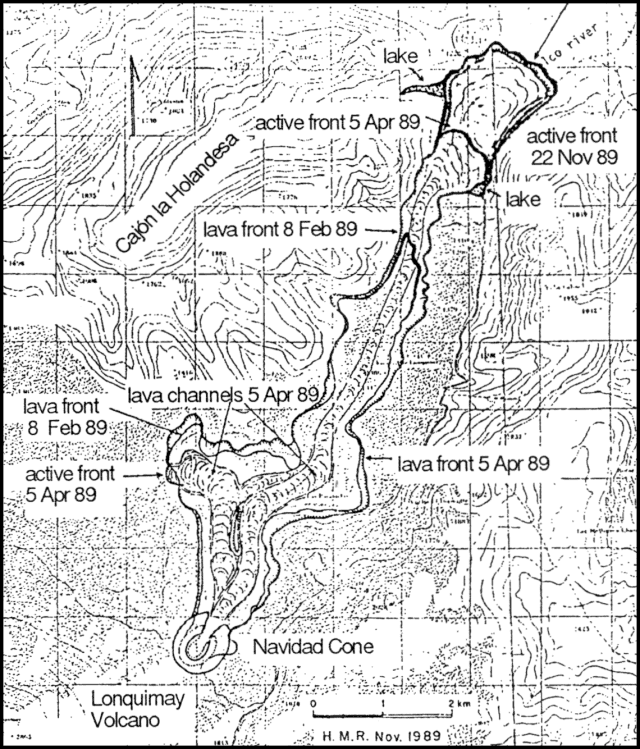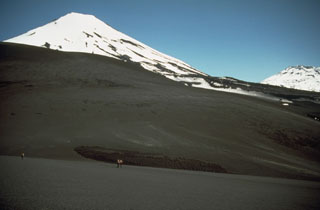Report on Lonquimay (Chile) — December 1989
Scientific Event Alert Network Bulletin, vol. 14, no. 12 (December 1989)
Managing Editor: Lindsay McClelland.
Lonquimay (Chile) Continued ash emission and lava production; strong SO2
Please cite this report as:
Global Volcanism Program, 1989. Report on Lonquimay (Chile) (McClelland, L., ed.). Scientific Event Alert Network Bulletin, 14:12. Smithsonian Institution. https://doi.org/10.5479/si.GVP.SEAN198912-357100
Lonquimay
Chile
38.379°S, 71.586°W; summit elev. 2832 m
All times are local (unless otherwise noted)
Ash emission and lava production, generally relatively weak, continued at Lonquimay. Stronger activity occurred on 27 and 28 November, when a dense cauliflower-shaped ash column rose 2,000-2,500 m above the vent and was carried SE (Lonquimay district). The press reported renewed stronger activity about 24 December, on the eve of the eruption's first anniversary, when gas and tephra were ejected to ~2,000 m height, and debris fell ~500 m away. Strong felt earthquakes and underground noise were associated with the activity.
For the first time since the eruption began almost 11 months earlier, geologists were able to reach the summit of Navidad cone during several days of fieldwork that began 19 November. Direct measurements indicated that the S, W, and E flanks were 150, 100, and 190 m high respectively. The inner walls of the main cone showed annular fractures denoting small (<5 m) partial collapses of the nested airfall deposits. Fumarolic activity occurred through the fractures; a temperature of 264°C was measured on the inner W wall. The air was saturated with acid gases 15 m below the main crater rim. Nested within the formerly horseshoe-shaped main crater, 400-450 m in diameter, was a funnel-shaped crater 50 m across. The more intense explosions (including bomb ejection) and steam jets emerged from vents in the wall and deeper parts of this crater. Tephra in the 500-m-high column consisted primarily of bombs and ash. Lapilli were very scarce, and most tephra were dense, fine, angular lithics, indicating Vulcanian-type behavior. Winds carried the plume SE.
William Rose reports that "COSPEC measurements 19 and 21 November under the plume at Portezuelo, 1.3 km SE of Navidad cone, revealed highly variable SO2 fluxes ranging from 300 to > 14,000 t/d. These are much higher than the 80-300 t/d measured by Kyle on 13 July. The November SO2 emission rates are in the lower part of the range of other measurements at actively erupting volcanoes. When compared with estimates of the lava effusion rate, the November SO2 fluxes suggest that Lonquimay lavas contain a high sulfur content and/or intrusive (unerupted) magma may be contributing sulfur to the Navidad plume."
Lava continued to emerge from a 3-m-wide vent at the NE foot of the cone. The lava surface had a black aa-like crust and moved at ~50-55 m/hour. On 21 November, the level of the top of the flow dropped substantially between observations at the vent at 1200 and 1830, leaving former hot levees perched as much as 3 m above the flow surface, although flow velocity seemed unchanged. These fluctuations precluded an accurate effusion rate estimate, but it probably exceeded 15 x 103 m3/day. Lava temperature measured by thermocouple 500 m from the vent was 934°C. The flow front was ~10.7 km from Navidad cone along the Lolco river (figure 15). Front thickness varied between 45 and 50 m. Since 17 September, the lava had covered an additional area of ~0.16 km2, representing lava production of ~7.2 x 106 m3 in 60 days, for a mean of 120 x 103 m3/day.
 |
Figure 15. Map showing the lava flow front and two lava-impounded lakes as of 22 November. Courtesy of H. Moreno. |
Two small lakes were impounded behind the lava flow, near the former channel of the Lolco river and in the La Holandesa valley, but the other three lakes observed on 17 September (14:9) had disappeared. Lolco river water emerged from under the flow front at 70°C, with a pH of 6.5.
In early August, a small flow of blocky lava had emerged from a vent midway down the cone's NE flank, aligned with the NE end of the fissure that has controlled the eruption. The flow, cold by November, was ~50 m long, 20 m wide, and 6 m thick.
Geological Summary. Lonquimay is a small, flat-topped, symmetrical stratovolcano of late-Pleistocene to dominantly Holocene age immediately SE of Tolguaca volcano. A glacier fills its summit crater and flows down the S flank. It is dominantly andesitic, but basalt and dacite are also found. The prominent NE-SW Cordón Fissural Oriental fissure zone cuts across the entire volcano. A series of NE-flank vents and scoria cones were built along an E-W fissure, some of which have been the source of voluminous lava flows, including those during 1887-90 and 1988-90, that extended out to 10 km.
Information Contacts: J. Naranjo, SERNAGEOMIN, Santiago; H. Moreno, Univ de Chile; W. Rose and R. Andres, Michigan Technological Univ; Santiago Domestic Service, Chile.

